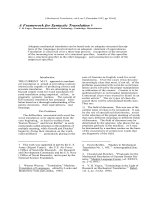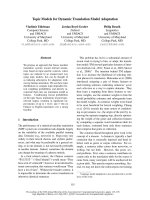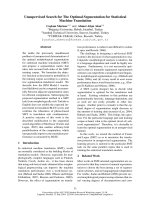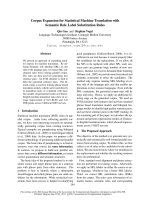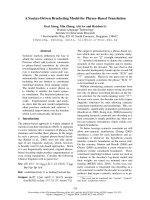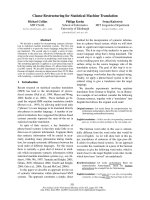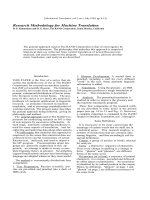Báo cáo khoa học: "Perplexity Minimization for Translation Model Domain Adaptation in Statistical Machine Translation" potx
Bạn đang xem bản rút gọn của tài liệu. Xem và tải ngay bản đầy đủ của tài liệu tại đây (176.85 KB, 11 trang )
Perplexity Minimization for Translation Model Domain Adaptation in
Statistical Machine Translation
Rico Sennrich
Institute of Computational Linguistics
University of Zurich
Binzmühlestr. 14
CH-8050 Zürich
Abstract
We move the focus away from a binary combination of in-domain and out-of-domain data. If
we can scale up the number of models whose contributions we weight, this reduces the need for a
priori knowledge about the fitness1 of each potential training text, and opens new research opportunities, for instance experiments with clustered
training data.
We investigate the problem of domain
adaptation for parallel data in Statistical
Machine Translation (SMT). While techniques for domain adaptation of monolingual data can be borrowed for parallel data,
we explore conceptual differences between
translation model and language model domain adaptation and their effect on performance, such as the fact that translation
models typically consist of several features
that have different characteristics and can
be optimized separately. We also explore
adapting multiple (4–10) data sets with no
a priori distinction between in-domain and
out-of-domain data except for an in-domain
development set.
1
2
Introduction
The increasing availability of parallel corpora
from various sources, welcome as it may be,
leads to new challenges when building a statistical machine translation system for a specific
domain. The task of determining which parallel texts should be included for training, and
which ones hurt translation performance, is tedious when performed through trial-and-error.
Alternatively, methods for a weighted combination exist, but there is conflicting evidence as to
which approach works best, and the issue of determining weights is not adequately resolved.
The picture looks better in language modelling, where model interpolation through perplexity minimization has become a widespread
method of domain adaptation. We investigate the
applicability of this method for translation models, and discuss possible applications.
Domain Adaptation for Translation
Models
To motivate efforts in domain adaptation, let us
review why additional training data can improve,
but also decrease translation quality.
Adding more training data to a translation system is easy to motivate through the data sparseness problem. Koehn and Knight (2001) show
that translation quality correlates strongly with
how often a word occurs in the training corpus.
Rare words or phrases pose a problem in several stages of MT modelling, from word alignment to the computation of translation probabilities through Maximum Likelihood Estimation.
Unknown words are typically copied verbatim to
the target text, which may be a good strategy for
named entities, but is often wrong otherwise. In
general, more data allows for a better word alignment, a better estimation of translation probabilities, and for the consideration of more context (in
phrase-based or syntactic SMT).
A second effect of additional data is not necessarily positive. Translations are inherently ambiguous, and a strong source of ambiguity is the
1
We borrow this term from early evolutionary biology to
emphasize that the question in domain adaptation is not how
“good” or “bad” the data is, but how well-adapted it is to the
task at hand.
539
Proceedings of the 13th Conference of the European Chapter of the Association for Computational Linguistics, pages 539–549,
Avignon, France, April 23 - 27 2012. c 2012 Association for Computational Linguistics
domain of a text. The German word “Wort” (engl.
word) is typically translated as floor in Europarl,
a corpus of Parliamentary Proceedings (Koehn,
2005), owing to the high frequency of phrases
such as you have the floor, which is translated into
German as Sie haben das Wort. This translation
is highly idiomatic and unlikely to occur in other
contexts. Still, adding Europarl as out-of-domain
training data shifts the probability distribution of
p(t|“Wort”) in favour of p(“floor”|“Wort”), and
may thus lead to improper translations.
We will refer to the two problems as the data
sparseness problem and the ambiguity problem.
Adding out-of-domain data typically mitigates the
data sparseness problem, but exacerbates the ambiguity problem. The net gain (or loss) of adding
more data changes from case to case. Because
there are (to our knowledge) no tools that predict
this net effect, it is a matter of empirical investigation (or, in less suave terms, trial-and-error), to
determine which corpora to use.2
From this understanding of the reasons for and
against out-of-domain data, we formulate the following hypotheses:
1. A weighted combination can control the contribution of the out-of-domain corpus on the
probability distribution, and thus limit the
ambiguity problem.
2. A weighted combination eliminates the need
for data selection, offering a robust baseline
for domain-specific machine translation.
We will discuss three mixture modelling techniques for translation models. Our aim is to adapt
all four features of the standard Moses SMT translation model: the phrase translation probabilities
p(t|s) and p(s|t), and the lexical weights lex(t|s)
and lex(s|t).3
2.1 Linear Interpolation
A well-established approach in language modelling is the linear interpolation of several models, i.e. computing the weighted average of the in2
A frustrating side-effect is that these findings rarely generalize. For instance, we were unable to reproduce the finding by Ceau¸u et al. (2011) that patent translation systems
s
are highly domain-sensitive and suffer from the inclusion of
parallel training data from other patent subdomains.
3
We can ignore the fifth feature, the phrase penalty,
which is a constant.
dividual model probabilities. It is defined as follows:
n
p(x|y; λ) =
λi pi (x|y)
(1)
i=1
with λi being the interpolation weight of each
model i, and with ( i λi ) = 1.
For SMT, linear interpolation of translation
models has been used in numerous systems. The
approaches diverge in how they set the interpolation weights. Some authors use uniform
weights (Cohn and Lapata, 2007), others empirically test different interpolation coefficients
(Finch and Sumita, 2008; Yasuda et al., 2008;
Nakov and Ng, 2009; Axelrod et al., 2011), others
apply monolingual metrics to set the weights for
TM interpolation (Foster and Kuhn, 2007; Koehn
et al., 2010).
There are reasons against all these approaches.
Uniform weights are easy to implement, but give
little control. Empirically, it has been shown that
they often do not perform optimally (Finch and
Sumita, 2008; Yasuda et al., 2008). An optimization of B LEU scores on a development set is
promising, but slow and impractical. There is no
easy way to integrate linear interpolation into loglinear SMT frameworks and perform optimization
through MERT. Monolingual optimization objectives such as language model perplexity have the
advantage of being well-known and readily available, but their relation to the ambiguity problem
is indirect at best.
Linear interpolation is seemingly well-defined
in equation 1. Still, there are a few implementation details worth pointing out. If we directly
interpolate each feature in the translation model,
and define the feature values of non-occurring
phrase pairs as 0, this disregards the meaning of
each feature. If we estimate p(x|y) via MLE as in
equation 2, and c(y) = 0, then p(x|y) is strictly
speaking undefined. Alternatively to a naive algorithm, which treats unknown phrase pairs as
having a probability of 0, which results in a deficient probability distribution, we propose and implement the following algorithm. For each value
pair (x, y) for which we compute p(x|y), we replace λi with 0 for all models i with p(y) =
0, then renormalize the weight vector λ to 1.
We do this for p(t|s) and lex(t|s), but not for
p(s|t) and lex(s|t), the reasoning being the con-
540
sequences for perplexity minimization (see section 2.4). Namely, we do not want to penalize
a small in-domain model for having a high outof-vocabulary rate on the source side, but we do
want to penalize models that know the source
phrase, but not its correct translation. A second modification pertains to the lexical weights
lex(s|t) and lex(t|s), which form no true probability distribution, but are derived from the individual word translation probabilities of a phrase
pair (see (Koehn et al., 2003)). We propose to
not interpolate the features directly, but the word
translation probabilities which are the basis of the
lexical weight computation. The reason for this is
that word pairs are less sparse than phrase pairs,
so that we can even compute lexical weights for
phrase pairs which are unknown in a model.4
2.2 Weighted Counts
Weighting of different corpora can also be implemented through a modified Maximum Likelihood
Estimation. The traditional equation for MLE is:
p(x|y) =
c(x, y)
=
c(y)
c(x, y)
x c(x , y)
(2)
where c denotes the count of an observation, and
p the model probability. If we generalize the formula to compute a probability from n corpora,
and assign a weight λi to each, we get5 :
p(x|y; λ) =
n
i=1 λi ci (x, y)
n
i=1
x λi ci (x , y)
(3)
The main difference to linear interpolation is
that this equation takes into account how wellevidenced a phrase pair is. This includes the distinction between lack of evidence and negative evidence, which is missing in a naive implementation of linear interpolation.
Translation models trained with weighted
counts have been discussed before, and have
been shown to outperform uniform ones in some
settings. However, researchers who demonstrated this fact did so with arbitrary weights (e.g.
(Koehn, 2002)), or by empirically testing different weights (e.g. (Nakov and Ng, 2009)). We do
not know of any research on automatically determining weights for this method, or which is not
limited to two corpora.
4
For instance if the word pairs (the,der) and (man,Mann)
are known, but the phrase pair (the man, der Mann) is not.
5
Unlike equation 1, equation 3 does not require that
( i λi ) = 1.
2.3
Alternative Paths
A third method is using multiple translation models as alternative decoding paths (Birch et al.,
2007), an idea which Koehn and Schroeder (2007)
first used for domain adaptation. This approach
has the attractive theoretical property that adding
new models is guaranteed to lead to equal or better performance, given the right weights. At best,
a model is beneficial with appropriate weights. At
worst, we can set the feature weights so that the
decoding paths of one model are never picked for
the final translation. In practice, each translation
model adds 5 features and thus 5 more dimensions
to the weight space, which leads to longer search,
search errors, and/or overfitting. The expectation
is that, at least with MERT, using alternative decoding paths does not scale well to a high number
of models.
A suboptimal choice of weights is not the only
weakness of alternative paths, however. Let us
assume that all models have the same weights.
Note that, if a phrase pair occurs in several models, combining models through alternative paths
means that the decoder selects the path with the
highest probability, whereas with linear interpolation, the probability of the phrase pair would
be the (weighted) average of all models. Selecting the highest-scoring phrase pair favours statistical outliers and hence is the less robust decision,
prone to data noise and data sparseness.
2.4
Perplexity Minimization
In language modelling, perplexity is frequently
used as a quality measure for language models
(Chen and Goodman, 1998). Among other applications, language model perplexity has been used
for domain adaptation (Foster and Kuhn, 2007).
For translation models, perplexity is most closely
associated with EM word alignment (Brown et
al., 1993) and has been used to evaluate different
alignment algorithms (Al-Onaizan et al., 1999).
We investigate translation model perplexity
minimization as a method to set model weights
in mixture modelling. For the purpose of optimization, the cross-entropy H(p), the perplexity
2H(p) , and other derived measures are equivalent.
The cross-entropy H(p) is defined as:6
6
See (Chen and Goodman, 1998) for a short discussion
of the equation. In short, a lower cross-entropy indicates that
the model is better able to predict the development set.
541
H(p) = −
p(x, y) log2 p(x|y)
˜
(4)
x,y
The phrase pairs (x, y) whose probability we
measure, and their empirical probability p need
˜
to be extracted from a development set, whereas
p is the model probability. To obtain the phrase
pairs, we process the development set with the
same word alignment and phrase extraction tools
that we use for training, i.e. GIZA++ and heuristics for phrase extraction (Och and Ney, 2003).
The objective function is the minimization of the
cross-entropy, with the weight vector λ as argument:
ˆ
λ = arg min −
λ
p(x, y) log2 p(x|y; λ)
˜
(5)
x,y
We can fill in equations 1 or 3 for p(x|y; λ). The
optimization itself is convex and can be done with
off-the-shelf software.7 We use L-BFGS with
numerically approximated gradients (Byrd et al.,
1995).
Perplexity minimization has the advantage that
it is well-defined for both weighted counts and linear interpolation, and can be quickly computed.
Other than in language modelling, where p(x|y)
is the probability of a word given a n-gram history, conditional probabilities in translation models express the probability of a target phrase given
a source phrase (or vice versa), which connects
the perplexity to the ambiguity problem. The
higher the probability of “correct” phrase pairs,
the lower the perplexity, and the more likely
the model is to successfully resolve the ambiguity. The question is in how far perplexity minimization coincides with empirically good mixture weights.8 This depends, among others, on
the other model components in the SMT framework, for instance the language model. We will
not evaluate perplexity minimization against empirically optimized mixture weights, but apply it
in situations where the latter is infeasible, e.g. because of the number of models.
7
A quick demonstration of convexity: equation 1 is
affine; equation 3 linear-fractional. Both are convex in the
domain R>0 . Consequently, equation 4 is also convex because it is the weighted sum of convex functions.
8
There are tasks for which perplexity is known to be unreliable, e.g. for comparing models with different vocabularies. However, such confounding factors do not affect the optimization algorithm, which works with a fixed set of phrase
pairs, and merely varies λ.
Our main technical contributions are as follows: Additionally to perplexity optimization for
linear interpolation, which was first applied by
Foster et al. (2010), we propose perplexity optimization for weighted counts (equation 3), and a
modified implementation of linear interpolation.
Also, we independently perform perplexity minimization for all four features of the standard SMT
translation model: the phrase translation probabilities p(t|s) and p(s|t), and the lexical weights
lex(t|s) and lex(s|t).
3
Other Domain Adaptation Techniques
So far, we discussed mixture modelling for translation models, which is only a subset of domain
adaptation techniques in SMT.
Mixture-modelling for language models is well
established (Foster and Kuhn, 2007). Language
model adaptation serves the same purpose as
translation model adaptation, i.e. skewing the
probability distribution in favour of in-domain
translations. This means that LM adaptation may
have similar effects as TM adaptation, and that
the two are to some extent redundant. Foster and
Kuhn (2007) find that “both TM and LM adaptation are effective”, but that “combined LM and
TM adaptation is not better than LM adaptation
on its own”.
A second strand of research in domain adaptation is data selection, i.e. choosing a subset of
the training data that is considered more relevant
for the task at hand. This has been done for language models using techniques from information
retrieval (Zhao et al., 2004), or perplexity (Lin et
al., 1997; Moore and Lewis, 2010). Data selection has also been proposed for translation models (Axelrod et al., 2011). Note that for translation models, data selection offers an unattractive
trade-off between the data sparseness and the ambiguity problem, and that the optimal amount of
data to select is hard to determine.
Our discussion of mixture-modelling is relatively coarse-grained, with 2-10 models being
combined. Matsoukas et al. (2009) propose an approach where each sentence is weighted according to a classifier, and Foster et al. (2010) extend this approach by weighting individual phrase
pairs. These more fine-grained methods need not
be seen as alternatives to coarse-grained ones.
Foster et al. (2010) combine the two, applying linear interpolation to combine the instance-
542
Data set
Alpine (in-domain)
Europarl
JRC Acquis
OpenSubtitles v2
Total train
Dev
Test
weighted out-of-domain model with an in-domain
model.
4 Evaluation
Apart from measuring the performance of the approaches introduced in section 2, we want to investigate the following open research questions.
1. Does an implementation of linear interpolation that is more closely tailored to translation modelling outperform a naive implementation?
4.1 Data and Methods
In terms of tools and techniques used, we mostly
adhere to the work flow described for the WMT
2011 baseline system9 . The main tools are Moses
(Koehn et al., 2007), SRILM (Stolcke, 2002), and
GIZA++ (Och and Ney, 2003), with settings as
described in the WMT 2011 guide. We report
two translation measures: B LEU (Papineni et al.,
2002) and METEOR 1.3 (Denkowski and Lavie,
2011). All results are lowercased and tokenized,
measured with five independent runs of MERT
(Och and Ney, 2003) and MultEval (Clark et al.,
2011) for resampling and significance testing.
We compare three baselines and four translation model mixture techniques. The three baselines are a purely in-domain model, a purely outof-domain model, and a model trained on the concatenation of the two, which corresponds to equation 3 with uniform weights. Additionally, we
evaluate perplexity optimization with weighted
counts and the two implementations of linear interpolation contrasted in section 2.1. The two linear interpolations that are contrasted are a naive
one, i.e. a direct, unnormalized interpolation of
9
/>html
words (fr)
4 700k
44 000k
24 000k
18 000k
91 000k
33 000
21 000
Table 1: Parallel data sets for German – French translation task.
Data set
Alpine (in-domain)
News-commentary
Europarl
News
Total
2. How do the approaches perform outside a
binary setting, i.e. when we do not work
with one in-domain and one out-of-domain
model, but with a higher number of models?
3. Can we apply perplexity minimization to
other translation model features such as the
lexical weights, and if yes, does a separate
optimization of each translation model feature improve performance?
sentences
220k
1 500k
1 100k
2 300k
5 200k
1424
991
sentences
650k
150k
2 000k
25 000k
28 000k
words
13 000k
4 000k
60 000k
610 000k
690 000k
Table 2: Monolingual French data sets for German –
French translation task.
all translation model features, and a modified one
that normalizes λ for each phrase pair (s, t) for
p(t|s) and recomputes the lexical weights based
on interpolated word translation probabilites. The
fourth weighted combination is using alternative
decoding paths with weights set through MERT.
The four weighted combinations are evaluated
twice: once applied to the original four or ten parallel data sets, once in a binary setting in which
all out-of-domain data sets are first concatenated.
Since we want to concentrate on translation
model domain adaptation, we keep other model
components, namely word alignment and the lexical reordering model, constant throughout the experiments. We contrast two language models. An
unadapted, out-of-domain language model trained
on data sets provided for the WMT 2011 translation task, and an adapted language model which is
the linear interpolation of all data sets, optimized
for minimal perplexity on the in-domain development set.
While unadapted language models are becoming more rare in domain adaptation research, they
allow us to contrast different TM mixtures without the effect on performance being (partially)
hidden by language model adaptation with the
same effect.
The first data set is a DE–FR translation scenario in the domain of mountaineering. The indomain corpus is a collection of Alpine Club pub-
543
lications (Volk et al., 2010). As parallel out-ofdomain dataset, we use Europarl, a collection of
parliamentary proceedings (Koehn, 2005), JRCAcquis, a collection of legislative texts (Steinberger et al., 2006), and OpenSubtitles v2, a parallel corpus extracted from film subtitles10 (Tiedemann, 2009). For language modelling, we use indomain data and data from the 2011 Workshop
on Statistical Machine Translation. The respective sizes of the data sets are listed in tables 1 and
2.
As the second data set, we use the Haitian Creole – English data from the WMT 2011 featured
translation task. It consists of emergency SMS
sent in the wake of the 2010 Haiti earthquake.
Originally, Microsoft Research and CMU operated under severe time constraints to build a translation system for this language pair. This limits
the ability to empirically verify how much each
data set contributes to translation quality, and increases the importance of automated and quick
domain adaptation methods.
Note that both data sets have a relatively high
ratio of in-domain to out-of-domain parallel training data (1:20 for DE–EN and 1:5 for HT–EN)
Previous research has been performed with ratios
of 1:100 (Foster et al., 2010) or 1:400 (Axelrod
et al., 2011). Since domain adaptation becomes
more important when the ratio of IN to OUT is
low, and since such low ratios are also realistic11 ,
we also include results for which the amount of
in-domain parallel data has been restricted to 10%
of the available data set.
We used the same development set for language/translation model adaptation and setting
the global model weights with MERT. While it
is theoretically possible that MERT will give too
high weights to models that are optimized on the
same development set, we found no empirical evidence for this in experiments with separate development sets.
4.2 Results
The results are shown in tables 5 and 6. In the
DE–FR translation task, results vary between 13.5
and 18.9 B LEU points; in the HT–EN task, between 24.3 and 33.8. Unsurprisingly, an adapted
10
We predict that the availability of parallel data will
steadily increase, most data being out-of-domain for any
given task.
11
Data set
SMS (in-domain)
Medical
Newswire
Glossary
Wikipedia
Wikipedia NE
Bible
Haitisurf dict
Krengle dict
Krengle
Total train
Dev
Test
units
16 500
1 600
13 500
35 700
8 500
10 500
30 000
3 700
1 600
650
120 000
900
1274
words (en)
380 000
10 000
330 000
90 000
110 000
34 000
920 000
4000
2 600
4 200
1 900 000
22 000
25 000
Table 3: Parallel data sets for Haiti Creole – English
translation task.
Data set
SMS (in-domain)
News
sentences
16k
113 000k
words
380k
2 650 000k
Table 4: Monolingual English data sets for Haiti Creole – English translation task.
LM performs better than an out-of-domain one,
and using all available in-domain parallel data is
better than using only part of it. The same is not
true for out-of-domain data, which highlights the
problem discussed in the introduction. For the
DE–FR task, adding 86 million words of out-ofdomain parallel data to the 5 million in-domain
data set does not lead to consistent performance
gains. We observe a decrease of 0.3 B LEU points
with an out-of-domain LM, and an increase of 0.4
B LEU points with an adapted LM. The out-ofdomain training data has a larger positive effect
if less in-domain data is available, with a gain of
1.4 B LEU points. The results in the HT–EN translation task (table 6) paint a similar picture. An
interesting side note is that even tiny amounts of
in-domain parallel data can have strong effects on
performance. A training set of 1600 emergency
SMS (38 000 tokens) yields a comparable performance to an out-of-domain data set of 1.5 million
tokens.
As to the domain adaptation experiments,
weights optimized through perplexity minimization are significantly better in the majority of
cases, and never significantly worse, than uniform
544
System
in-domain
out-of-domain
counts (concatenation)
binary in/out
weighted counts
linear interpolation (naive)
linear interpolation (modified)
alternative paths
4 models
weighted counts
linear interpolation (naive)
linear interpolation (modified)
alternative paths
out-of-domain LM
full IN TM
B LEU METEOR
16.8
35.9
13.5
31.3
16.5
35.7
adapted LM
full IN TM
small IN TM
B LEU METEOR B LEU METEOR
17.9
37.0
15.7
33.5
14.8
32.3
14.8
32.3
18.3
37.3
17.1
35.4
17.4
17.4
17.2
17.2
36.6
36.7
36.5
36.5
18.7
18.8
18.9
18.6
37.9
37.9
38.0
37.8
17.6
17.6
17.6
17.4
36.2
36.1
36.2
36.0
17.3
17.1
17.2
17.0
36.6
36.5
36.5
36.2
18.8
18.5
18.7
18.3
37.8
37.7
37.9
37.4
17.4
17.3
17.3
16.3
36.0
35.9
36.0
35.1
Table 5: Domain adaptation results DE–FR. Domain: Alpine texts. Full IN TM: Using the full in-domain parallel
corpus; small IN TM: using 10% of available in-domain parallel data.
weights.12 However, the difference is smaller for
the experiments with an adapted language model
than for those with an out-of-domain one, which
confirms that the benefit of language model adaptation and translation model adaptation are not
fully cumulative. Performance-wise, there seems
to be no clear winner between weighted counts
and the two alternative implementations of linear interpolation. We can still argue for weighted
counts on theoretical grounds. A weighted MLE
(equation 3) returns a true probability distribution,
whereas a naive implementation of linear interpolation results in a deficient model. Consequently,
probabilities are typically lower in the naively interpolated model, which results in higher (worse)
perplexities. While the deficiency did not affect
MERT or decoding negatively, it might become
problematic in other applications, for instance if
we want to use an interpolated model as a component in a second perplexity-based combination of
models.13
When moving from a binary setting with
one in-domain and one out-of-domain translation model (trained on all available out-of-domain
data) to 4–10 translation models, we observe a
serious performance degradation for alternative
paths, while performance of the perplexity opti12
This also applies to linear interpolation with uniform
weights, which is not shown in the tables.
13
Specifically, a deficient model would be dispreferred by
the perplexity minimization algorithm.
mization methods does not change significantly.
This is positive for perplexity optimization because it demonstrates that it requires less a priori
information, and opens up new research possibilities, i.e. experiments with different clusterings of
parallel data. The performance degradation for
alternative paths is partially due to optimization
problems in MERT, but also due to a higher susceptibility to statistical outliers, as discussed in
section 2.3.14
A pessimistic interpretation of the results
would point out that performance gains compared
to the best baseline system are modest or even
inexistent in some settings. However, we want
to stress two important points. First, we often
do not know a priori whether adding an out-ofdomain data set boosts or weakens translation performance. An automatic weighting of data sets reduces the need for trial-and-error experimentation
and is worthwhile even if a performance increase
is not guaranteed. Second, the potential impact
of a weighted combination depends on the translation scenario and the available data sets. Generally, we expect non-uniform weighting to have
a bigger impact when the models that are combined are more dissimilar (in terms of fitness for
the task), and if the ratio of in-domain to out-ofdomain data is low. Conversely, there are situa14
We empirically verified this weakness in a synthetic experiment with a randomly split training corpus and identical
weights for each path.
545
System
in-domain
out-of-domain
counts (concatenation)
binary in/out
weighted counts
linear interpolation (naive)
linear interpolation (modified)
alternative paths
10 models
weighted counts
linear interpolation (naive)
linear interpolation (modified)
alternative paths
out-of-domain LM
full IN TM
B LEU METEOR
30.4
30.7
24.3
28.0
30.3
31.2
adapted LM
full IN TM
small IN TM
B LEU METEOR B LEU METEOR
33.4
31.7
29.7
28.6
28.9
30.2
28.9
30.2
33.6
32.4
31.3
31.3
31.0
30.8
30.8
30.8
31.6
31.4
31.5
31.3
33.8
33.7
33.7
33.2
32.4
32.4
32.4
32.4
31.5
31.9
31.7
29.8
31.3
31.3
31.2
30.7
31.0
30.9
31.0
25.9
31.5
31.4
31.6
29.2
33.5
33.8
33.8
24.3
32.3
32.4
32.5
29.1
31.8
31.9
32.1
29.8
31.5
31.3
31.5
30.9
Table 6: Domain adaptation results HT–EN. Domain: emergency SMS. Full IN TM: Using the full in-domain
parallel corpus; small IN TM: using 10% of available in-domain parallel data.
tions where we actually expect a simple concatenation to be optimal, e.g. when the data sets have
very similar probability distributions.
4.2.1 Individually Optimizing Each TM
Feature
weights
It is hard to empirically show how translation
model perplexity optimization compares to using
monolingual perplexity measures for the purpose
of weighting translation models, as e.g. done by
(Foster and Kuhn, 2007; Koehn et al., 2010). One
problem is that there are many different possible
configurations for the latter. We can use source
side or target side language models, operate with
different vocabularies, smoothing techniques, and
n-gram orders.
One of the theoretical considerations that
favour measuring perplexity on the translation
model rather than using monolingual measures
is that we can optimize each translation model
feature separately. In the default Moses translation model, the four features are p(s|t), lex(s|t),
p(t|s) and lex(t|s).
We empirically test different optimization
schemes as follows. We optimize perplexity on
each feature independently, obtaining 4 weight
vectors. We then compute one model with one
weight vector per feature (namely the feature that
the vector was optimized on), and four models
that use one of the weight vectors for all features.
A further model uses a weight vector that is the
perplexity
2
3
1
4
weighted counts
uniform
5.12 7.68 4.84 13.67
separate
4.68 6.62 4.24 8.57
4.68 6.84 4.50 10.86
1
2
4.78 6.62 4.48 10.54
3
4.86 7.31 4.24 9.15
4
5.33 7.87 4.52 8.57
average
4.72 6.71 4.38 9.95
linear interpolation (modified)
uniform 19.89 82.78 4.80 10.78
separate
5.45 8.56 4.28 8.85
1
5.45 8.79 4.40 8.89
2
5.71 8.56 4.54 8.91
3
6.46 11.88 4.28 9.07
4
6.12 10.86 4.47 8.85
average
5.73 9.72 4.34 8.89
LM
6.01 9.83 4.56 8.96
B LEU
30.3
31.0
30.3
30.3
30.8
30.9
30.4
30.6
31.0
30.8
30.9
31.0
30.9
30.9
30.8
Table 7: Contrast between a separate optimization of
each feature and applying the weight vector optimized
on one feature to the whole model. HT–EN with outof-domain LM.
546
average of the other four. For linear interpolation,
we also include a model whose weights have been
optimized through language model perplexity optimization, with a 3-gram language model (modified Knesey-Ney smoothing) trained on the target
side of each parallel data set.
Table 7 shows the results. In terms of B LEU
score, a separate optimization of each feature is a
winner in our experiment in that no other scheme
is better, with 8 of the 11 alternative weighting
schemes (excluding uniform weights) being significantly worse than a separate optimization. The
differences in B LEU score are small, however,
since the alternative weighting schemes are generally felicitious in that they yield both a lower
perplexity and better B LEU scores than uniform
weighting. While our general expectation is that
lower perplexities correlate with higher translation performance, this relation is complicated by
several facts. Since the interpolated models are
deficient (i.e. their probabilities do not sum to 1),
perplexities for weighted counts and our implementation of linear interpolation cannot be compard. Also, note that not all features are equally
important for decoding. Their weights in the loglinear model are set through MERT and vary between optimization runs.
5
Conclusion
This paper contributes to SMT domain adaptation
research in several ways. We expand on work
by (Foster et al., 2010) in establishing translation model perplexity minimization as a robust
baseline for a weighted combination of translation
models.15 We demonstrate perplexity optimization for weighted counts, which are a natural extension of unadapted MLE training, but are of little prominence in domain adaptation research. We
also show that we can separately optimize the four
variable features in the Moses translation model
through perplexity optimization.
We break with prior domain adaptation research in that we do not rely on a binary clustering
of in-domain and out-of-domain training data. We
demonstrate that perplexity minimization scales
well to a higher number of translation models.
This is not only useful for domain adaptation, but
for various tasks that profit from mixture mod15
The source code is available in the Moses repository
/>
elling. We envision that a weighted combination
could be useful to deal with noisy datasets, or applied after a clustering of training data.
Acknowledgements
This research was funded by the Swiss National
Science Foundation under grant 105215_126999.
References
Yaser Al-Onaizan, Jan Curin, Michael Jahr, Kevin
Knight, John Lafferty, Dan Melamed, Franz-Josef
Och, David Purdy, Noah A. Smith, and David
Yarowsky. 1999. Statistical machine translation.
Technical report, Final Report, JHU Summer Workshop.
Amittai Axelrod, Xiaodong He, and Jianfeng Gao.
2011. Domain adaptation via pseudo in-domain
data selection. In Proceedings of the EMNLP 2011
Workshop on Statistical Machine Translation.
Alexandra Birch, Miles Osborne, and Philipp Koehn.
2007. CCG supertags in factored statistical machine translation. In Proceedings of the Second
Workshop on Statistical Machine Translation, pages
9–16, Prague, Czech Republic, June. Association
for Computational Linguistics.
Peter F. Brown, Vincent J. Della Pietra, Stephen A.
Della Pietra, and Robert L. Mercer. 1993. The
Mathematics of Statistical Machine Translation:
Parameter Estimation. Computational Linguistics,
19(2):263–311.
Richard H. Byrd, Peihuang Lu, Jorge Nocedal, and
Ciyou Zhu. 1995. A limited memory algorithm
for bound constrained optimization. SIAM J. Sci.
Comput., 16:1190–1208, September.
Alexandru Ceau¸u, John Tinsley, Jian Zhang, and
s
Andy Way. 2011. Experiments on domain adaptation for patent machine translation in the PLuTO
project. In Proceedings of the 15th conference of
the European Association for Machine Translation,
Leuven, Belgium.
Stanley F. Chen and Joshua Goodman. 1998. An empirical study of smoothing techniques for language
modeling. Computer Speech & Language, 13:359–
393.
Jonathan H. Clark, Chris Dyer, Alon Lavie, and
Noah A. Smith. 2011. Better hypothesis testing for
statistical machine translation: Controlling for optimizer instability. In Proceedings of the 49th Annual Meeting of the Association for Computational
Linguistics: Human Language Technologies, pages
176–181, Portland, Oregon, USA, June. Association for Computational Linguistics.
Trevor Cohn and Mirella Lapata. 2007. Machine
Translation by Triangulation: Making Effective Use
of Multi-Parallel Corpora. In Proceedings of the
547
45th Annual Meeting of the Association of Computational Linguistics, pages 728–735, Prague, Czech
Republic, June. Association for Computational Linguistics.
Michael Denkowski and Alon Lavie. 2011. Meteor
1.3: Automatic Metric for Reliable Optimization
and Evaluation of Machine Translation Systems. In
Proceedings of the EMNLP 2011 Workshop on Statistical Machine Translation.
Andrew Finch and Eiichiro Sumita. 2008. Dynamic
model interpolation for statistical machine translation. In Proceedings of the Third Workshop on
Statistical Machine Translation, StatMT ’08, pages
208–215, Stroudsburg, PA, USA. Association for
Computational Linguistics.
George Foster and Roland Kuhn. 2007. Mixturemodel adaptation for smt. In Proceedings of the
Second Workshop on Statistical Machine Translation, StatMT ’07, pages 128–135, Stroudsburg, PA,
USA. Association for Computational Linguistics.
George Foster, Cyril Goutte, and Roland Kuhn. 2010.
Discriminative instance weighting for domain adaptation in statistical machine translation. In Proceedings of the 2010 Conference on Empirical Methods
in Natural Language Processing, pages 451–459,
Stroudsburg, PA, USA. Association for Computational Linguistics.
Philipp Koehn and Kevin Knight. 2001. Knowledge
sources for word-level translation models. In Lillian Lee and Donna Harman, editors, Proceedings
of the 2001 Conference on Empirical Methods in
Natural Language Processing, pages 27–35.
Philipp Koehn and Josh Schroeder. 2007. Experiments in domain adaptation for statistical machine
translation. In Proceedings of the Second Workshop on Statistical Machine Translation, StatMT
’07, pages 224–227, Stroudsburg, PA, USA. Association for Computational Linguistics.
Philipp Koehn, Franz Josef Och, and Daniel Marcu.
2003. Statistical phrase-based translation. In
NAACL ’03: Proceedings of the 2003 Conference
of the North American Chapter of the Association
for Computational Linguistics on Human Language
Technology, pages 48–54, Morristown, NJ, USA.
Association for Computational Linguistics.
Philipp Koehn, Hieu Hoang, Alexandra Birch,
Chris Callison-Burch, Marcello Federico, Nicola
Bertoldi, Brooke Cowan, Wade Shen, Christine
Moran, Richard Zens, Chris Dyer, Ondˇej Bojar,
r
Alexandra Constantin, and Evan Herbst. 2007.
Moses: Open Source Toolkit for Statistical Machine Translation. In ACL 2007, Proceedings of the
45th Annual Meeting of the Association for Computational Linguistics Companion Volume Proceedings of the Demo and Poster Sessions, pages 177–
180, Prague, Czech Republic, June. Association for
Computational Linguistics.
Philipp Koehn, Barry Haddow, Philip Williams, and
Hieu Hoang. 2010. More linguistic annotation
for statistical machine translation. In Proceedings
of the Joint Fifth Workshop on Statistical Machine
Translation and MetricsMATR, pages 115–120, Uppsala, Sweden, July. Association for Computational
Linguistics.
Philipp Koehn. 2002. Europarl: A Multilingual Corpus for Evaluation of Machine Translation.
Philipp Koehn. 2005. Europarl: A parallel corpus for
statistical machine translation. In Machine Translation Summit X, pages 79–86, Phuket, Thailand.
Sung-Chien Lin, Chi-Lung Tsai, Lee-Feng Chien,
Keh-Jiann Chen, and Lin-Shan Lee. 1997. Chinese
language model adaptation based on document classification and multiple domain-specific language
models. In George Kokkinakis, Nikos Fakotakis,
and Evangelos Dermatas, editors, EUROSPEECH.
ISCA.
Spyros Matsoukas, Antti-Veikko I. Rosti, and Bing
Zhang. 2009. Discriminative corpus weight estimation for machine translation. In Proceedings of
the 2009 Conference on Empirical Methods in Natural Language Processing: Volume 2 - Volume 2,
pages 708–717, Stroudsburg, PA, USA. Association
for Computational Linguistics.
Robert C. Moore and William Lewis. 2010. Intelligent selection of language model training data. In
Proceedings of the ACL 2010 Conference Short Papers, ACLShort ’10, pages 220–224, Stroudsburg,
PA, USA. Association for Computational Linguistics.
Preslav Nakov and Hwee Tou Ng. 2009. Improved
statistical machine translation for resource-poor
languages using related resource-rich languages. In
Proceedings of the 2009 Conference on Empirical Methods in Natural Language Processing: Volume 3 - Volume 3, EMNLP ’09, pages 1358–1367,
Stroudsburg, PA, USA. Association for Computational Linguistics.
Franz Josef Och and Hermann Ney. 2003. A systematic comparison of various statistical alignment
models. Computational Linguistics, 29(1):19–51.
Kishore Papineni, Salim Roukos, Todd Ward, and
Wei-Jing Zhu. 2002. Bleu: A method for automatic
evaluation of machine translation. In ACL ’02: Proceedings of the 40th Annual Meeting on Association for Computational Linguistics, pages 311–318,
Morristown, NJ, USA. Association for Computational Linguistics.
Ralf Steinberger, Bruno Pouliquen, Anna Widiger,
Camelia Ignat, Tomaz Erjavec, Dan Tufis, and
Daniel Varga. 2006. The JRC-Acquis: A multilingual aligned parallel corpus with 20+ languages. In
Proceedings of the 5th International Conference on
Language Resources and Evaluation (LREC’2006).
548
A. Stolcke. 2002. SRILM – An Extensible Language
Modeling Toolkit. In Seventh International Conference on Spoken Language Processing, pages 901–
904, Denver, CO, USA.
Jörg Tiedemann. 2009. News from opus - a collection of multilingual parallel corpora with tools
and interfaces. In N. Nicolov, K. Bontcheva,
G. Angelova, and R. Mitkov, editors, Recent
Advances in Natural Language Processing, volume V, pages 237–248. John Benjamins, Amsterdam/Philadelphia, Borovets, Bulgaria.
Martin Volk, Noah Bubenhofer, Adrian Althaus, Maya
Bangerter, Lenz Furrer, and Beni Ruef. 2010. Challenges in building a multilingual alpine heritage
corpus. In Proceedings of the Seventh conference
on International Language Resources and Evaluation (LREC’10), Valletta, Malta. European Language Resources Association (ELRA).
Keiji Yasuda, Ruiqiang Zhang, Hirofumi Yamamoto,
and Eiichiro Sumita. 2008. Method of selecting
training data to build a compact and efficient translation model. In Proceedings of the 3rd International Joint Conference on Natural Language Processing (IJCNLP).
Bing Zhao, Matthias Eck, and Stephan Vogel. 2004.
Language model adaptation for statistical machine
translation with structured query models. In Proceedings of the 20th international conference on
Computational Linguistics, COLING ’04, Stroudsburg, PA, USA. Association for Computational Linguistics.
549
